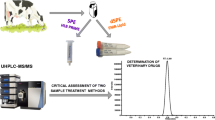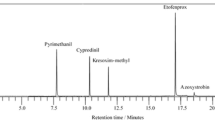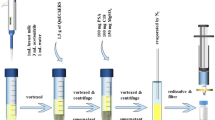Abstract
A liquid chromatography tandem mass spectrometry (LC-MS/MS) method with modified QuEChERS (quick, easy, cheap, effective, rugged and safe) extraction cleaning process was comprehensively validated for determination of 167 pesticide residues in three matrices: milk, cheese and cream. Optimisation of the mass spectrometry parameters was performed by injecting pesticide standard solutions into the electrospray ion (ESI) source. The mass spectrometer was operated in the positive ESI mode. The validation data fulfilled the requirements of the European SANTE/11945/2015 Guideline. The specificity of the developed method is considered satisfactory. Good linearity (R 2 > 0.99) was obtained for all pesticide matrix calibration curves within the range of 0.1–100 μg kg−1. Mean recoveries of all target analytes ranged from 80.4 to 117.3%, and limits of quantification (LOQ) ranged from 1.1 to 13.1 μg kg−1, depending on pesticide residues. The repeatability and within-laboratory reproducibility ranged from 0.2 to 15.1% and from 1.3 to 19.4%, respectively. The uncertainty was not higher than 48% for target analytes in the three matrices. The validated method was successfully applied to screening of milk and milk products, and none of the 167 pesticides investigated was detected in 92 real samples.

Similar content being viewed by others
References
Anastassiades M, Lehotay SJ, Stajnbaher D, Schenck FJ (2003) Fast and easy multiresidue method employing acetonitrile extraction/partitioning and “dispersive solid-phase extraction” for the determination of pesticide residues in produce. J AOAC Int 86:412–431
Official Method AOAC (2007) Pesticide residues in foods by acetonitirile extraction and partitioning with magnesium sulphate. J AOAC Int 90:485
Bakırcı GT, Acay DBY, Bakırcı F, Ötleş S (2014) Pesticide residues in fruits and vegetables from the Aegean region, Turkey. Food Chem 160:379–392
Berrada H, Fernández MJ, Ruiz MJ, Moltó JC, Mañes J, Font G (2010) Surveillance of pesticide residues in fruits from Valencia during twenty months (2004/05). Food Control 21(1):36–44
Chen X, Bian Z, Hou H, Yang F, Liu S, Tang G (2013) Development and validation of a method for the determination of 159 pesticide residues in tobacco by gas chromatography–tandem mass spectrometry. J Agric Food Chem 61:5746–5757
Cieślik E, Sadowska-Rociek A, Molina Ruiz JM, Surma-Zadora M (2011) Evaluation of QuEChERS method for the determination of organochloride pesticide residues in selected groups of fruits. Food Chem 125:773–778
De A, Bose R, Kumar A, Mozumdar S (2014) Targeted delivery of pesticides using biodegradable polymeric nanoparticles. SpringerBriefs in Molecular Science, Springer, New Delhi
Du X, Ren YL, Beckett SJ (2016) An innovative rapid method for analysis of 10 organophosphorus pesticide residues in wheat by HS-SPME-GC-FPD/MSD. J AOAC Int 99:520–526
Ellison SLR, Rosselin M, Williams A (2000) Quantifying uncertainty in analytical measurement. EURACHEM/CITAC Guide CG 4:1–120
EURACHEM (1998) The fitness for purpose of analytical methods. A laboratory guide to method validation and related topics. Middlesex, TW11 OLY, United Kingdom: EURACHEM Working Group
European Commission (2002) Commission Decision of 12 August 2002 implementing Council Directive 96/23/EC concerning the performance of analytical methods and interpretation of results (2002/657/EC). Off J Eur Communities OJ L 221:8–36
European Commission (2015) Guidance document on analytical quality control and method validation procedures for pesticides residues analysis in food and feed. Document No. SANTE/12945/2015. European Commission Directorate-General for Health and Food Safety. Available from http://ec.europa.eu/food/plant/doc/plant_pesticides_mrl_guidelines_wrkdoc_11945_en.pdf
Farajzadeh MA, Khoshmaram L, Nabil AAA (2014) Determination of pyrethroid pesticides residues in vegetable oils using liquid-liquid extraction and dispersive liquid-liquid microextraction followed by gas chromatography–flame ionization detection. J Food Compos Anal 34:128–135
Fenik J, Tankiewicz M, Biziuk M (2011) Properties and determination of pesticides in fruits and vegetables. TrAC Trends Anal Chem 30:814–826
Golge O, Kabak B (2015) Evaluation of QuEChERS sample preparation and liquid chromatography-triple-quadrupole mass spectrometry method for the determination of 109 pesticide residues in tomatoes. Food Chem 176:319–332
Hotchkiss JH (1992) Pesticide residue controls to ensure food safety. Crit Rev Food Sci Nutr 31:191–203
Hyotylainen T, Tuutijarvi T, Kousmanen K, Riekkola ML (2002) Determination of pesticide residues in red wines with microporous membrane liquid-liquid extraction and gas chromatography. Anal Bioanal Chem 372:732–736
ISO/IEC 17025:2005 (2005) General requirements for the competence of testing and calibration laboratories. Available from http://www.iso.org
Iwafune T, Ogino T, Watanabe E (2014) Water-based extraction and liquid chromatography–tandem mass spectrometry analysis of neonicotinoid insecticides and their metabolites in green pepper/tomato samples. J Agric Food Chem 62:2790–2796
Lozowicka B, Ilyasova G, Kaczynski P, Jankowska M, Rutkowska E, Hrynko I, Mojsak P, Szabunko J (2016) Multi-residue methods for the determination of over four hundred pesticides in solid and liquid high sucrose content matrices by tandem mass spectrometry coupled with gas and liquid chromatography. Talanta 151:51–61
Mokbel H, Al Dine EJ, Elmoll A, Liaud C, Millet M (2016) Simultaneous analysis of organochlorine pesticides and polychlorinated biphenyls in air samples by using accelerated solvent extraction (ASE) and solid-phase micro-extraction (SPME) coupled to gas chromatography dual electron capture detection. Environ Sci Pollut R 23:8053–8063
Muñoz NC, Floriano L, de Souza MP, Bandeira NMG, Prestes OD, Zanella R (2017) Determination of pesticide residues in golden berry (Physalis peruviana L.) by modified QuEChERS method and ultra-high performance liquid chromatography-tandem quadrupole mass spectrometry. Food Anal Methods 10:320–329
Park JY, Choi JH, El-Aty AMA, Kim BM, Oh JH, Do JA, Kwon KS, Shim KH, Choi OJ, Shin SC, Shim JH (2011) Simultaneous multiresidue analysis of 41 pesticide residues in cooked foodstuff using QuEChERS: comparison with classical method. Food Chem 128:241–253
Restrepo AR, Ortiz AFG, Ossa DEH, Mesa GAP (2014) QuEChERS GC–MS validation and monitoring of pesticide residues in different foods in the tomato classification group. Food Chem 158:153–161
Saito-Shida S, Nemoto S, Matsuda R (2014) Multiresidue analysis of pesticides in vegetables and fruits by supercritical fluid extraction and liquid chromatography-tandem mass spectrometry. J Food Hyg Soc Jpn 55:142–151
Singh SB, Foster GD, Khan SU (2004) Microwave-assisted extraction for the simultaneous determination of thiamethoxam, imidacloprid, and carbendazim residues in fresh and cooked vegetable samples. J Agric Food Chem 52:105–109
Ueno E, Oshima H, Saito I, Matsumoto H, Yoshimura Y, Nakazawa H (2004) Multiresidue analysis of pesticides in vegetables and fruits by gas chromatography/mass spectrometry after gel permeation chromatography and graphitized carbon column clean-up. J AOAC Int 87:1003–1015
WHO (2010) Exposure to highly hazardous pesticides: a major public health concern. WHO Document Production Services, Geneva
Zhao P, Huang B, Li Y, Han Y, Zou N, Gu K, Li X, Pan C (2014) Rapid multiplug filtration cleanup with multiple-walled carbon nanotubes and gas chromatography–triple–quadrupole mass spectrometry detection for 186 pesticide residues in tomato and tomato products. J Agric Food Chem 62:3710–3725
Author information
Authors and Affiliations
Corresponding author
Ethics declarations
Conflict of Interest
Ozgur Golge declares that he has no conflict of interest. Ahmet Koluman declares that he has no conflict of interest. Bulent Kabak declares that he has no conflict of interest.
Ethical Approval
This article does not contain any studies with human participants or animals performed by any of the authors.
Informed Consent
Not applicable.
Rights and permissions
About this article
Cite this article
Golge, O., Koluman, A. & Kabak, B. Validation of a Modified QuEChERS Method for the Determination of 167 Pesticides in Milk and Milk Products by LC-MS/MS. Food Anal. Methods 11, 1122–1148 (2018). https://doi.org/10.1007/s12161-017-1066-0
Received:
Accepted:
Published:
Issue Date:
DOI: https://doi.org/10.1007/s12161-017-1066-0




